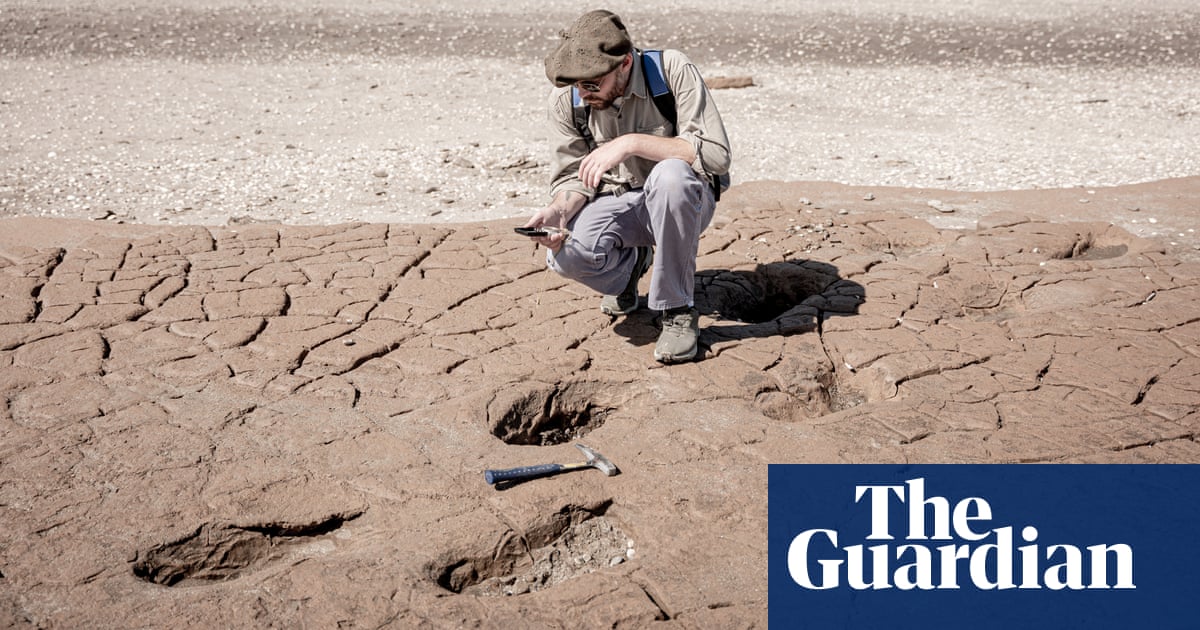
Far from the recognisable image of the white-bearded father of modern biology, when Charles Darwin embarked on his expedition into the unknown, he was a young man who had twice disappointed his family.
Darwin had already abandoned his medical studies at Edinburgh University, where he had found himself more enthralled by a student natural history group than medicine, and was fresh from Cambridge, where he had decided a life as an Anglican minister was also not for him. At 22, he began his odyssey on board HMS Beagle, a Royal Navy ship commanded by Capt Robert FitzRoy. That trip to South America, between December 1831 and October 1836, was described by Darwin as “by far the most important event in my life and has determined my whole career”, and continues to fascinate scientists to this day.
On their journey to the southernmost tip of the Americas, Darwin documented places such as Bahía Blanca, Punta Alta, Puerto Deseado, Puerto San Julián and Ushuaia in Argentina, and Punta Arenas in Chile. His passage through the Galápagos became world-renowned. But one stage of the voyage is less celebrated: Patagonia, where the Beagle and her 80 or so crew spent more than half of the five years.
Darwin travelled long distances around the region on foot and horseback because he suffered terrible sea sickness, periodically meeting the Beagle as it made its stops. The crew stayed onboard to carry out their work, inspecting coastlines, mapping ports, measuring sea depths and making topographical surveys to produce accurate maps for Britain’s commercial interests.
Darwin’s expeditions through Patagonia coincided with the Argentine “desert campaign” against the Indigenous people. The leader of this offensive, Gen Juan Manuel de Rosas – later a president of Argentina – received the young Darwin in his camp and granted him free passage to Buenos Aires. Darwin, the son of British abolitionists, was impressed by his leadership but wrote about the ongoing genocide in his diaries.
“The warfare is too bloody to last; the Christians killing every Indian, and the Indians doing the same by the Christians. It is melancholy to trace how the Indians have given way before the Spanish invaders … Not only have whole tribes been exterminated, but the remaining Indians have become more barbarous: instead of living in large villages, and being employed in the arts of fishing, as well as of the chase, they now wander about the open plains, without home or fixed occupation.”
In Punta Alta, at the gateway of Patagonia to the north, Darwin’s legacy remains vivid. He spent 45 days in the city, and every year, on 22 September, they celebrate the day in 1832 when he found fossils here. In Darwin’s writings, he could not contain his excitement. “I have been wonderfully lucky with fossil bones – some of the animals must have been of great dimensions: I am almost sure that many of them are quite new,” he wrote.
Darwin collected many large mammal fossils in the region, several of them recorded for the first time, such as the Mylodon darwinii (a three-metre-tall sloth) and Toxodon platensis (a hippopotamus-like herbivore). Both became extinct about 10,000 years ago. Experts recognise that these findings were the evidence that led Darwin to refute the doctrine of the fixity of species, the then-popular notion that species are immutable, which European scientists had adopted, influenced by the Catholic church and biblical creationist perspective.
It is the reason physiologist Richard Keynes, Darwin’s great-grandson, considered 22 September 1832 a watershed moment for modern biology. In the 1980s, Keynes went to see the place that proved so important to his great-grandfather and found a very different scene from that which had enchanted Darwin. As the Punta Alta Municipal Historical Archive states: “The current landscape has undergone great modifications at the hands of man.”
The city of Punta Alta did not officially exist in 1832 and nor did the Port Belgrano naval base, built on one of the fields where Darwin made discoveries and which became an infamous torture centre during the Argentine dictatorship in the 70s and 80s.
Discoveries in the region did not stop with Darwin. In 1986, the site of Pehuen Có was recorded by two Argentine palaeontologists, Teresa Manera and Silvia Aramayo. They identified well-preserved footprints of mammals and birds from the Pleistocene – a period that began 2m years ago and in which, according to scientific evidence, Homo erectus, the direct ancestor of Homo sapiens, appeared. Scientists have identified footprints of 22 animal species in Pehuen Có, including mastodons and camelids.
Manera is director of the Charles Darwin Municipal Museum of Natural Sciences, which fights to preserve historical sites, a real challenge in the modern commercial city of Punta Alta. Today a paleontological site just three kilometres from the museum is under threat from the work of a sand-mining company.
“When they find new fossils, they do not warn us. These materials are not being studied. And, in the provincial reserve on the beach, which Darwin did not visit, the impact of tourism is very big,” she says. “People do not understand they cannot drive their cars over the beach sand because it causes coastal erosion. It is something that is affecting the entire coast.”
According to Manera, Darwin was the hero of the great Argentine researchers, such as Florentino Ameghino, considered the father of palaeontology, who died in 1911. “Reading his diaries, I realised how sensitive Darwin was, besides being a brilliant observer. What he wrote was accurate. His power to observe and analyse was remarkable. What fascinates me the most is his viewpoint, how he looked at things, how he observed our world,” she says.
When the Beagle anchored at Puerto Deseado, in front of the ruins of a Spanish colony abandoned due to the climate and hostility of the locals, Darwin dedicated a large part of his time to observing the guanaco (Lama guanicoe). The scene was drawn by Conrad Martens, the expedition’s draughtsman, in which the crew is seen camping next to the river with a high volcanic rock. “I don’t think I’ve ever seen a place that seemed more isolated from the world than this rocky cleft in the middle of the wild plain,” Darwin wrote in his diary that day.
The river was muddy and shallow, and attempts to advance towards the mountain range proved unsuccessful, and so the crew soon returned to the coast. The site, now within a farm, has become known as Campamento Darwin. A few metres from the riverbank, one can find cave paintings from between 4,000 and 7,000 years ago.
Farther south, in Puerto San Julián, named by Ferdinand Magellan in 1520 on the first circumnavigation of the world, the geology of Patagonia impressed Darwin. He found one of the largest deposits of pebbles in the world, which came from the Andes down to the Atlantic.
In 1834, the Beagle arrived in Pacific waters. Near the islands of Tierra del Fuego, south of Chile, and in honour of the ship’s naturalist’s 25th birthday, FitzRoy named the highest peak of a mountain range Mount Darwin. Later, in Punta Arenas, Darwin and FitzRoy went together to the cemetery to visit the grave of the former captain of the Beagle, Pringle Stokes, who shot himself in 1828, during the ship’s first expedition to the region.
The inscription on Stokes’s tomb states he died “from the effects of the anxieties and hardships incurred while surveying the western shores of Tierra del Fuego”. The original grave marker is at the Maggiorino Borgatello Museum in Punta Arenas, Chile.
In an entry in his journal, dated 29 September 1836, Darwin says of Patagonia that “among the scenes which are deeply impressed on my mind, none exceed in sublimity the primaeval forests undefaced by the hands of man; whether those of Brazil, where the powers of life are predominant, or whether those of Tierra del Fuego, where death and decay prevail”.
In Punta Arenas today, Marcelo Leppe, a palaeobiologist and director of the Chile Antarctic Institute, carries on the work of Darwin. Leppe was part of the team that discovered a new species of ankylosaurus, a family of dinosaurs known as “armoured dinosaurs”. The Stegouros elengassen, as it was named, had a mighty bony tail that was an effective weapon. In 2021, Leppe co-authored a paper in Nature after he and his team discovered it in a remote location. Researchers began exploring this area only 12 years ago.
Tierra del Fuego was the first place where this unknown comes in – the wonder, the discoveries and perhaps the fear
Janet Owen, The Earth Museum
Leppe says: “Darwin brought concrete evidence that this continent was connected with the world, Antarctica and Oceania. He collected many animal and plant species in natural history when we did not know much. Sometimes, we even forget that he was such a young scientist.
“Working with evolution implies directly confronting the reality that Darwin observed. When I arrived in Punta Arenas in 2006, I saw that the setting had not changed much. It felt as if I was seeing what Darwin saw.”
However, although Darwin is regarded as a science hero and visionary genius and had expressed anti-racist values throughout his life, he wrote disparagingly of the Indigenous peoples of the south of Tierra del Fuego, especially the Yaghan, who travelled in canoes between the islands and had an incredible ability to adapt to the most extreme conditions.
Darwin described them as “miserable degraded savages”. He wrote: “I could not have believed how wide was the difference between savage and civilised man: it is greater than between a wild and domesticated animal. He also wrote that “viewing such men, one can hardly make oneself believe that they are fellow-creatures, and inhabitants of the same world”.
During the Beagle’s expedition, people from all over Tierra del Fuego were beginning to suffer persecution. Throughout the 19th and 20th centuries, they were massacred, especially by the military campaigns that aimed to dominate Patagonia.
Victor Vargas Filgueira from Ushuaia is a 52-year-old Yaghan and a survivor. According to the 2017 census, 1,600 people declared themselves Yaghan in Argentina.
According to Filgueira “the real story is not the one told”. He believes Darwin is one of those who collaborated to take his people “to a place of isolation, away from society, without rights, in a dehumanising process”.
His form of resistance is to tell his own story and that of his people, talking to the public daily, at the End of the World Museum.
Filgueira says he tells “a story that makes us understand who we are – and I try to show people that we are talking about one of the most severe genocides of humanity”. He clings to an old parable to believe change is possible: “They will be surprised when the children of their children understand what they did not understand.”
According to Janet Owen, executive director of The Earth Museum, who explored the multisensory experiences of Darwin’s collections, Tierra del Fuego was where Darwin truly came alive. “Tierra del Fuego was the first place where this unknown comes in – the wonder, the strangeness, the excitement, the discoveries and perhaps the fear,” she says.
Owen says the trip “brought him to contact with a myriad of people, landscapes, languages, life-threatening situations, excitement, scientific observation”, which he spent the rest of his life analysing and drawing upon. “He brought his own worldviews, values, beliefs and prejudices into this mix from his imperial liberal, new science, male upbringing.”
Without Patagonia, she says, his deep thoughts about the bigger secrets of this world would not have been possible.
This story was supported by the National Geographic Society











